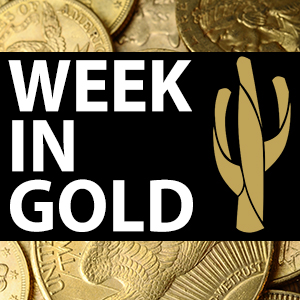This Week In Gold by Scottsdale Bullion and Coin
 The big news this past week was an announcement from The Federal Reserve that they would continue to gradually reduce the billion dollar bond-buying program, also known as Quantitative Easing (QE). As expected, stocks responded positively and gold took a hit. (At the time of this article, gold was trading at $1,292.17 an ounce, down 0.86% on the day).
The big news this past week was an announcement from The Federal Reserve that they would continue to gradually reduce the billion dollar bond-buying program, also known as Quantitative Easing (QE). As expected, stocks responded positively and gold took a hit. (At the time of this article, gold was trading at $1,292.17 an ounce, down 0.86% on the day).
Gold received some more bad news this week, with Forbes reporting that gold failed to rally despite Iraq making the largest gold purchase by a single nation in the last three years. Quoting a story first reported by Bloomberg News, the article claims that the Central Bank of Iraq bought gold to support the Iraqi dinar against foreign currencies.
Usually when news of a large purchase is reported, especially by a long-term holder like a central bank, gold futures spike up. In this case, April gold futures on the Comex division of the New York Mercantile Exchange were only up $1.80 an ounce at $1,313 on March 25th.
“News that Iraq has purchased some $1.5 billion of gold – over 1.1 million ounces – (this) month – has not helped at all. The market sentiment is if a million ounces was purchased and we are now lower, what a bearish sign,” said Steve Scacalossi, director, head of sales, global metals at TD Securities.
Not all analysts viewed the lack of a strong rally as a sign of danger, however. Phil Flynn, senior market analyst with Price Futures Group, believes that the Iraq purchase will be a “longer-term supportive feature for the market even if the news did not prompt an immediate sharp surge higher. For the near term, the market seems more focused on the future of U.S. Federal Reserve monetary policy.”
Despite a string of bad news for gold, reports of a possible escalation between Russia and the Ukraine may lead to a boost for the yellow metal. According to News.Com.Au 1, a senior military academic is warning that Europe is “staring down the barrel of its biggest war since 1945.”
The commander of NATO forces in Europe paid a visit to the White House yesterday on a mission to voice his concerns about Russia’s “massive military build-up facing eastern Ukraine.”
By the end of the weekend, Europe's biggest war since 1945 will have begun or Putin will have started to send the troops on the border home.
— John Schindler (@20committee) March 27, 2014
John Schindler, Professor of the Naval War College at Boston University, is also alarmed: “By the end of the weekend, Europe’s biggest war since 1945 will have begun or Putin will have started to send the troops on the border home.”
According to reports, the troops that Putin has mobilized are some of the most highly trained in the Russian Federation and they are joined by mechanized infantry units and their tanks. The U.S. Defense Department has taken that stance that the number of troops is too large to be considered a training exercise, but they also have seen no evidence of any large-scale military maneuvers.
Even if the situation is not as dire as some experts fear, there is no doubt that tensions are rising and something is going to have to give.
Additional Sources

